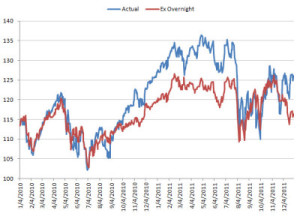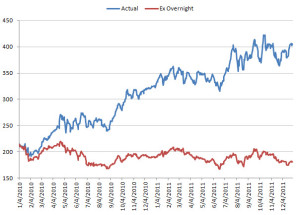[dc]T[/dc]here are a few good reasons for developing traders to daytrade, but also many compelling reasons not to. Many of the significant moves in markets happen in the overnight session–if you daytrade, think how many times you have come in to find a market gapped up or down, and then been frustrated as there is no significant action during the trading day. You were not just unlucky. You were on the wrong side of a verifiable principle of market behavior.

This chart shows the ETF for the S&P 500 index (Nyse: SPY) for the two years ending 12/31/2011. The blue line is the daily close price for the index; the red line is a theoretical price with the overnight gaps backed out. (In other words, if the index closed yesterday at 100.00, opened this morning at 100.50, and closed today at 101.00, the blue line would show an increase of 1.00. However 0.50 of that 1.00 price change was the overnight gap, so the red line would only increase to 100.50.)
I chose this particular time period because it was recent, not because it illustrated the point especially well. If you are interested, it pays to repeat this analysis on other segments of market history and you will see the same point–many times, virtually all of an extended, major rally happens in the overnight sessions. This example is a bit less than dramatic, but it is still easy to see that the red line lags on the rally significantly.


This is an example in the broad market, but what happens with individual stocks? Consider the example of Lululemon Athetica, Inc (Nasdaq: LULU), a high-flying market leader in the retail space. Over the time period covered in this chart, the stock price nearly quadrupled. However, the majority of that move happened overnight, and daytraders did not find nearly the same opportunities; without overnight gaps, the stock price never even doubled.
One last example will drive home the point: The stock of Apple, Inc. (Nasdaq: AAPL) more than doubled over these two years. With overnight gaps backed out, the stock price fluctuated between the initial price and a 25% loss. In all of these examples, a significant rally and price appreciation could have been entirely attributed to the overnight gaps. Take them out, and you have… nothing.
So what does this mean? In markets, we are paid for assuming the correct risks at the correct time, and managing them appropriately. Many times, understanding what those correct risks are requires some counter-intuitive thinking, and things that might seem to be prudent risk management (e.g., very tight stops) often amount to virtually certain losses over a large sample size. Daytraders often see overnight gaps as insurmountable risks to be avoided, but they do not understand that the majority of the opportunities in equities come in those overnight gaps. Risk is the unavoidable companion of opportunity. There can be no enduring success in the market until we fully embrace this truth.

great post!
Glad to have you back!
I can verify from my experience that very tight stops alone are NOT effective risk management. I have used them to justify marginal trades, or poor entry levels, often with a fear of missing a move, producing losses over a large sample size. After finally realizing it, I’m working to break the habit.
Welcome back. Looking forward to the book release.
Pingback: Wednesday links: leaving money on the table | Abnormal Returns
I have tested some other stocks: most of stocks that I tested exhibit this behavior, but there are some exceptions: For example, AMZN and MSFT gains mostly during trading session. Any thought on the difference?